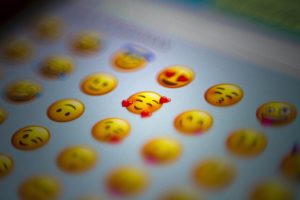MODULE 8: DEPRESSION
DEPRESSION
This module aligns with key elements of APNA’s “Growth & Development” and “Clinical Decision Making” (American Psychiatric Nurses Association Education Council, Undergraduate Branch, 2022).
Module Outline
- Assessment of Depressive Disorders
- Nursing Diagnoses Associated with Depressive Disorders
- Treatment of Depressive Disorders
Module Learning Outcomes
- Describe the signs and symptoms of depressive disorders.
- Identify the common nursing diagnoses associated with depressive disorders.
- Summarize the treatment of depressive disorders.
Concepts
- Mood
- Affect
- Safety
- Legal and Ethical Issues
Depressive Disorders
Depending on the text resource, a discussion of the diagnosis of Depression may be presented within a singular chapter as in this resource or within a chapter titled Mood Disorders. If the resource uses a Mood Disorders chapter, this will typically follow with a presentation of two distinct groups—individuals with depressive disorders and individuals with bipolar disorders. The key difference between the two mood disorder groups is episodes of mania/hypomania associated with Bipolar diagnosis.
The two most common types of depressive disorders are Major Depressive Disorder and Persistent Depressive Disorder. Persistent Depressive Disorder, previously known as Dysthymia, is a continuous and chronic form of depression. While the symptoms of Persistent Depressive Disorder are very similar to Major Depressive Disorder, they are usually less acute, as symptoms tend to ebb and flow over a long period of time (more than two years).
Below is an overview of a nurse’s consideration for the assessment, problems, and treatment of depression.
Assessment
When making a diagnosis of depression, there is a wide range of symptoms that may be present. These symptoms can generally be categorized into four categories: mood, behavioral, cognitive, and physical symptoms.
Mood
While clinical depression can vary in its presentation among individuals, most, if not all individuals with depression will report significant mood disturbances such as a depressed mood for most of the day and/or feelings of anhedonia, which is the loss of interest in previously interesting activities. Affect (i.e., the outward expression of mood) is typically blunted or flat. You might think of affect as you would emojis.
Behavioral
Behavioral issues such as decreased physical activity and reduced productivity—both at home and work—are often observed in individuals with depression. They may lack motivation to complete tasks (i.e., avolition). This is typically where a disruption in daily functioning occurs as individuals with depressive disorders are unable to maintain their social interactions and employment responsibilities.
Cognitive
It should not come as a surprise that there is a serious disruption in cognition as individuals with depressive disorders typically hold a negative view of themselves and the world around them. They are quick to blame themselves when things go wrong, and rarely take credit when they experience positive achievements. Individuals with depressive disorders often feel worthless, which creates a negative feedback loop by reinforcing their overall depressed mood. Individuals with depressive disorder also report difficulty concentrating on tasks, as they are easily distracted from outside stimuli. Finally, thoughts of suicide and self-harm do occasionally occur in those with depressive disorders; this will be discussed in the epidemiology section in more detail.
Physical
Changes in sleep patterns are common in those experiencing depression with reports of both hypersomnia and insomnia. Hypersomnia, or excessive sleeping, often impacts an individual’s daily functioning as they spend the majority of their time sleeping as opposed to participating in daily activities (i.e., meeting up with friends, getting to work on time). Reports of insomnia are also frequent and can occur at various points throughout the night including difficulty falling asleep, staying asleep, or waking too early with the inability to fall back asleep before having to wake for the day. Although it is unclear whether symptoms of fatigue or loss/lack of energy (i.e., anergia) are related to insomnia issues, the fact that those experiencing hypersomnia also report symptoms of fatigue suggests that these symptoms are a component of the disorder rather than a secondary symptom of sleep disturbance.
Additional physical symptoms, such as a change in weight or appetite/eating behaviors, are also observed. Some individuals who are experiencing depression report a lack of appetite, often forcing themselves to eat something during the day. On the contrary, others overeat, often seeking “comfort foods,” such as those high in carbohydrates. Due to these changes in eating behaviors, there may be associated changes in weight.
Psychomotor agitation or retardation, which is the purposeless or slowed physical movement of the body (i.e., pacing around a room, tapping toes, restlessness, etc.) is also reported in individuals with depressive disorders. Finally, individuals may have poverty of speech (i.e., alogia).
- Think of A Words when assessing S/S of depression: anergia, anhedonia, avolition, alogia, appetite change, a change in sleep.
- Heldt (2017) uses the mnemonic SIGECAPS to remember the S/S of depression.
Sleep Disturbance, Interest (decreased), Guilt and/or hopelessness, Energy (decreased), Concentration (impaired), Appetite (decreased), Psychomotor retardation, Suicidal thoughts

- It is imperative to assess for suicidal/homicidal thoughts. Nurses should ask about suicidal/homicidal thoughts in a matter-of-fact way.
- “Are you having thoughts of harming yourself or someone else?” Followed by, “Do you have a plan to harm yourself or someone else? If the response is affirmative, ask about the plan and place the patient on suicide precautions.
Instruments
The Major Depression Inventory (MDI) (“PsychTools”, n.d.) can be used to assess major depression or degree of an individuals’ depression
Problems
Problems commonly associated with a Depression diagnosis are:
-
Self-directed violence, the risk for
-
Hopelessness
-
Coping, ineffective
-
Self-Esteem, chronic low
-
Fatigue
-
Nutrition, imbalanced, less than body requirements (Chand, Arif, et al., 2022).
Treatment
Given that Major Depressive Disorder is among the most frequent and debilitating psychiatric disorders, it should not be surprising that the research on this disorder is quite extensive. Some treatment options include antidepressant medications, Cognitive-Behavioral Therapy (CBT), Interpersonal Therapy (IPT), and Electroconvulsive Therapy (ECT). ECT is typically not a first-line treatment but can be used for individuals not responding to medication therapy (Chand, Arif, et al., 2022).
Multimodal treatment
While both pharmacological and psychological treatment alone is very effective in treating depression, a combination of the two treatments may offer additional benefits, particularly in the maintenance of wellness and long-term relief of symptoms. Additionally, multimodal treatment options may be helpful for individuals who have not achieved wellness in a single modality.
Nursing Care
Nursing care is directed toward the assessment of the aforementioned mood, behavioral, cognitive, and physical signs and symptoms typically observed with depression.
Typical Signs and Symptoms of Depression with example interventions:
- Sleep disturbance-promote a safe, therapeutic environment conducive to rest and well-being.
- Interest/pleasure reduction-provide a nonjudgmental, supportive therapeutic milieu.
- Guilt feelings or thoughts of worthlessness-encourage expression of inward thoughts and feelings.
- Energy changes/fatigue-ensure a thorough assessment of potential causes of fatigue.
- Concentration/attention impairment-provide a low-stimulating, quiet environment for self-reflection.
- Appetite/weight changes-monitor daily weight; supplement nutrition with protein and finger foods as necessary.
- Psychomotor disturbances-ensure baseline assessment of psychomotor function; consult physical therapy if needed.
- Suicidal thoughts-assess suicide risk daily and with any changes in behavior; implement suicide precautions with close monitoring as needed.
- Depressed mood-evaluate depressed mood rating on a numerical scale, where 1 is a low rating and 10 is a highly depressed mood.
- All patients with depression should be evaluated for suicidal risk. Any suicide risk must be given prompt attention which could include hospitalization or close and frequent monitoring (Chand, Arif, et al., 2022).
Mental Health Promotion
There are various ways to promote mental health and well-being. Long-term treatment for depression should include mental health promotion approaches.
Some specific mental health promotion strategies discussed in Videbeck (2020) directed at mood disorders, including depression diagnoses and suicide risk include.
- Improve screening and diagnosis in primary care settings
- Create a crisis or relapse prevention plan
- Cultivate a social support network
- Incorporate behavioral changes that promote optimum health
- Encourage the patient to develop solutions.
Visit the MODULE 5-MENTAL HEALTH PROMOTION chapter to learn more about this topic.
Dr. Tracey Marks. (2019). How to tell if you’re depressed [Video]. YouTube. https://youtube.com/watch?v=XCAQHpXqIA8&si=EnSIkaIECMiOmarE
Key Takeaways & Concept Map Activity
You should have learned the following in this section:
- Treatment of depressive disorders includes psychopharmacological options AND/OR psychotherapy options including CBT and interpersonal therapy (IPT). A combination of the two main approaches often works best, especially in relation to the maintenance of wellness.
- Ask about suicidal/homicidal thoughts matter of factly “Are you having any thoughts of harming yourself or others?” If they answer affirmatively, ask about their plan to do so and notify the independent healthcare provider.
Concept Map Activity
- Create a concept map that depicts the assessment and treatment of Depression.
- If needed, see the INTRODUCTION for a concept map tutorial.
Adapted from Fundamentals of Psychological Disorders 2nd Edition- Module 4 by Alexis Bridley, Ph.D. and Lee W. Daffin Jr., Ph.D. licensed under a Creative Commons Attribution 4.0 International License. Modifications: revised for clarity and flow ![]() .
.
The outward expression of one's mood.
Suicide precautions are implemented for patients at high suicide risk. Meaning, the patient has indicated thoughts and/or plans of suicide. Patients, who have indicated thoughts of self-harm are generally admitted to an acute care behavioral unit. Interventions typically include continuous monitoring, finger foods only (no metal utensils), and no objects that the patient could potentially use for self-harm (e.g., shoe strings, belts, no pens/pencils).
Milieu (one's environment)
Watch this video to understand the concept of milieu therapy.


